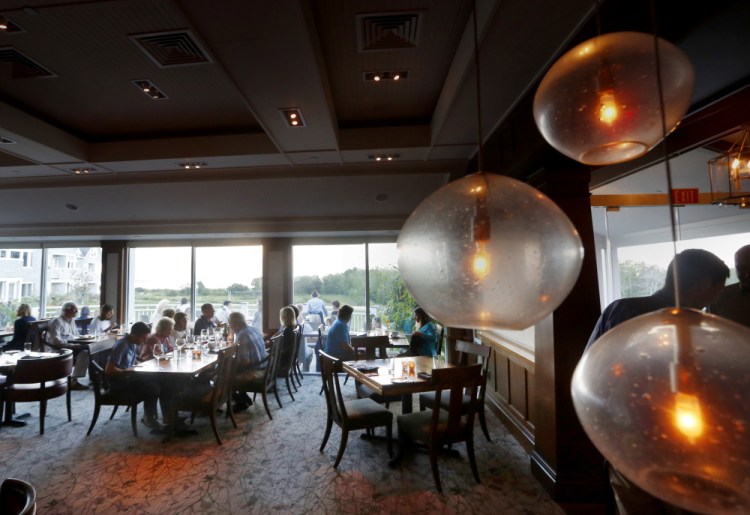When you walk into Inn by the Sea and admire the cottages and the flowers and the sailboats tacking in the distance, you may notice something missing. It’s the back wall, replaced here by enormous plate glass windows and doors that admit the spectacular view.
Something’s missing at Sea Glass, too, the small restaurant tucked into a corner of the resort in Cape Elizabeth. It isn’t elegance, which the upscale inn provides in spades. Or good service, which the exceedingly polite (and impossibly young) waiters and waitresses offer enthusiastically. It’s consistency. Executive chef Steve Sicinski, who took over in April, has introduced a menu with a range of seasonal dishes and an impressive selection of entrees and appetizers for those with dietary restrictions. A few are very good, but others are underseasoned or seriously lacking in flavor. And with prices as high as $39 for a bone-in filet of beef, a few “good” selections isn’t good enough. You long for both starters and main courses that taste consistently great.
The kitchen definitely has the skill to showcase and prepare fresh ingredients. A bowl of gazpacho ($11), served with blue corn chips and a small mound of guacamole, was vibrant and pleasantly sweet, filled with concentrated tomato flavor and impeccably seasoned. (Too many gazpachos taste like sodium-laced V8 juice. Sicinski’s version, perhaps because he has a background in spa cuisine, is a savory, summery exception.) I also liked the texture of the gazpacho – smooth but not thin – and the rich red color. There were cherry tomatoes growing in the luxuriant flower pots outside on the porch, and I asked one of the waiters if any of the plantings made their way into the soup. “Not yet,” he said. “Maybe later in the season.”
Another good starter was lamb meatballs ($13), served in one of the restaurant’s asymmetrical white bowls with a dollop of tzatziki, the Greek yogurt dressing, on the side. The meatballs were tender and piping hot, a fine contrast to the cool dressing filled with chunks of cucumber and bits of dill. I savored bites of the juicy lamb, dipping each morsel first into the tart dressing and then into a spoonful of tomatoey “vodka sauce” (the creamy version usually served with penne) on the side.
Unfortunately, my friend’s kale salad ($11), a shredded mixture of kale, cabbage, chopped tomatoes, cucumber and sprouts, proved disappointing. Though the ribbons of Tuscan kale were fresh and the slivers of red cabbage a crunchy complement, the promised “fresh ginger dressing” was so watery I half wondered if I they’d forgotten it. And while the presentation was attractive – the salad filled a clear glass bowl that looked like a broad-brimmed hat turned upside down and had shreds of carrots tossed in for color – the dish was eminently forgettable.
So was the pork shank ($26), a generous serving that fell from the bone but had little flavor. I kept returning to the shank searching for spice or seasoning or, frankly, any taste at all. Another friend, who tried a bite, shook her head as well. “Bland,” she concluded. The best part of this dish were the sides: an herbed spaetzle (that’s where the salt that the pork deserved must have ended up) and a mound of satisfying, barely bitter greens that had been braised in bacon.
Perhaps, I thought, it’s the wrong season for a long-simmered meat dish; maybe something lighter and simpler would be better? And, happily, a piece of grilled salmon ($26) was excellent. The fillet tasted mild and moist and was just cooked through. This time, though, while the centerpiece of the dish soared, the accompaniments sank: pan-fried noodles under the salmon were swimming in a kale and corn broth that had heat but little taste, and the handful of “foraged mushrooms” that looked so appetizing in the bowl also proved to be flavorless.
I half wondered if two teams were at work in the kitchen, one working with seasonings and the other without because the duck that another friend ordered was spiceless, while the confit-and-cabbage rolls served with it were piquant standouts. I pushed the lackluster duck to the side (though billed as “crispy,” the skin was not) and bit into one of the fried rolls. Here’s where they’re hiding this entree’s flavor, I thought. I bit through the crackling wrapper and savored the way it dissolved slowly on my tongue, revealing tender chunks of succulent duck leg that tasted even better dipped into the tangerine glaze in the bowl. It’s early days in Sicinski’s tenure, but if everything he introduces at Sea Glass can rise to the level of the confit-and-cabbage rolls, he’ll be on to something.
We looked out the window of the restaurant over the tables lined up on the porch (you can make reservations to sit inside or outside) and toward Crescent Beach to the south. The room was quiet, with about a dozen tables filling the wood-lined space. It would be easy to forget you’re in a hotel – the restaurant feels like an elegant, tranquil club. It’s easy to see why the restaurant is popular with guests and locals (who receive a 15 percent reduction of their bill upon request).
I wish dessert helped to change my impressions of Sea Glass, but a bite of lemon blueberry custard tart ($8) only reinforced the unpredictable experience. The tart looked good, the blueberries were fresh and the shavings of white chocolate on the side were a nice addition, but the tart was bland. A drizzle of lemon sauce on the side was the single source of bold flavor on the plate.
Sea Glass has a host of things going for it: a waterfront location 15 minutes from downtown Portland, exceptional service, beautifully maintained grounds and a jaw-dropping view. Based on the license plates we saw in the parking lot, the inn’s owners have found the attributes to attract guests from all over. But for their restaurant to really shine, the kitchen needs to find what’s missing.
James H. Schwartz has covered food, travel and architecture for The Washington Post, Downeast, Coastal Living and Southern Living magazines for more than 30 years. Long a commuter between Portland and Washington, D.C., he retired from his job as vice president at the National Trust for Historic Preservation in 2013 and relocated to Maine.
Send questions/comments to the editors.




Success. Please wait for the page to reload. If the page does not reload within 5 seconds, please refresh the page.
Enter your email and password to access comments.
Hi, to comment on stories you must . This profile is in addition to your subscription and website login.
Already have a commenting profile? .
Invalid username/password.
Please check your email to confirm and complete your registration.
Only subscribers are eligible to post comments. Please subscribe or login first for digital access. Here’s why.
Use the form below to reset your password. When you've submitted your account email, we will send an email with a reset code.